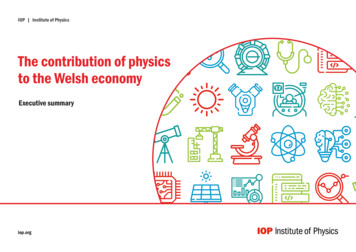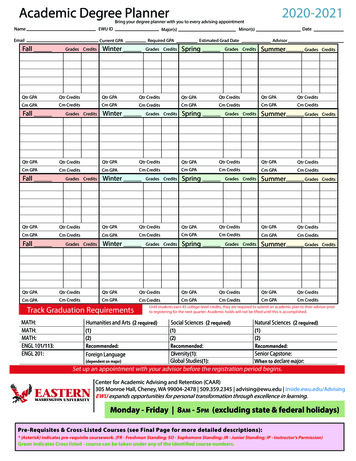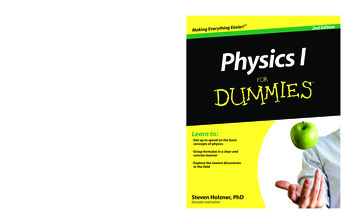
Transcription
DESCRIBING MOTION: KINEMATICS IN ONE DIMENSIONAP PhysicsSection 2-1 Reference Frames and Displacement
Model the velocity of the ball fromthe time it leaves my hand till thetime it hits the ground?
THINK ABOUT IT Is it a 1D or 2 D if it goes straight up and comes back? When will you call a ball traveling upwards 2D and WHY? If a car moves in a circle on the ground is it 1D or 2 D?
DESCRIBING MOTION: KINEMATICS IN ONE DIMENSIONMechanics – study of motion, force, energyKinematics – how objects moveDynamics – why objects moveTranslational Motion – move without rotation2-1
VELOCITY Rate ofchange of position Δx/ΔtACCELERATION Rate ofchange of Velocity ΔV/Δt
AVERAGE AND INSTANTANEOUS VELOCITYVavg Δx/Δt (Xf-Xi)/(tf-ti)Vinst LimΔt- 0 (Δx/Δt ) dx/dt
Area under the curve – Total displacement
AVERAGE AND INSTANTANEOUS ACCELERATION
DESCRIBING MOTION: KINEMATICS IN ONE DIMENSIONPositive – up andrightNegative – down andleftGraph in distant-timegraph :1. Constant position2. Constant Velocity3. ConstantAcceleration2-1
RECAP the Average Velocity / Average Speed In the qualifying round of the 50-yd freestyle in the sectionalswimming championship, Dugan got an early lead by finishing thefirst 25.00 yd in 10.01 seconds. Dugan finished the return leg(25.00 yd distance) in 10.22 seconds.a. Determine Dugan's average speed forthe entire race.b. Determine Dugan's average speed for the first 25.00 yd legof the race.c. Determine Dugan's average velocity for the entire race.a. 2.472 yd/sb. 2.498 yd/sc. 0 yd/s
During the annual shuffleboard competition, Renee gives her puckan initial speed of 9.32 m/s. Once leaving her stick, the puck slowsdown at a rate of -4.06 m/s/s.a. Determine the time it takes the puck to slow to a stop.b. Use your initial speed and the calculated time to determinethe average speed and the distance which the puck travelsbefore stopping.a. 2.30 sb. 10.7 m
You drive a beat-up pickup truck along a straightroad for8.4 km at 70 km/hr., at which point the truck runs out ofgasoline and stops. Over next 30 minutes, you walk another2.0 km farther along the road to a gas station.(a)Whatis your over all displacement?(b)What is the time difference Δt from the beginning of yourdrive to your arrival at the station?(c)What is your average velocity from the beginning of yourdrive to your arrival at the station? Find both numericallyand graphically.
The following equations give the position x(t) of a particlein four situations (in each equation, x is in meters, t is inseconds, and t 0):(1) x 3t - 2;(2) x - 4t2 - 2;(3) x 2/t2;(4) x - 2.(a) In which situation is the velocity v of the particleconstant?(a) In which situation is the velocity v in the negative xdirection?
CLASSWORK 1 Work in groups to solve.
CONSTANT ACCELERATIONA SPECIAL CASE.Velocity increases or decreases at a constantrate.(Draw the v-t graph)
Whatdo you know about Constant Acceleration andAverage velocity?For Constant AccelerationAvg Velocity is (V0 Vf)/2“Because velocity function is linear”
For constant acceleration why is Vavg 1/2(Vo V f)
AVERAGE QUESTIONA car slows down uniformly from a speed of 21.0 m/s torest in 6.00s. How far did it travel in this time?x (v v0 )t12x (21m / s)(6s) 63m122-6
DESCRIBING MOTION: KINEMATICS IN ONE DIMENSIONAverage Acceleration – change in velocity per unit time (vector) (meters/second2)v is final velocityv0 is initial velocity (or at time 0)Sign of a indicates direction of vectorDeceleration is just negative accelerationDv v - v0a Dt t - t02-4
THINK ABOUT IT!From the equationVf2 – V02 2 a (X-X0)Find out the Sign of Acceleration when1.The object is travelling in direction and speeding up2.The object is travelling in direction and slowing down3.The object is travelling in - direction and speeding up4.The object is travelling in - direction and slowing down
VELOCITY & ACCELERATION SIGN CHARTVELOCITYACCELERATION - -Moving forward;Moving backward;Speeding upSlowing downMoving forward;Moving backward;Slowing downSpeeding up
AREA UNDER THE CURVE Velocityfrom t0 to t1 is area under thecurve of Acceleration graph from t0 to t1 Displacementfrom t0 to t1 is area underthe curve of Velocity graph from t0 to t1
CHALLENGE PROBLEMA car is behind a truck going 25m/s on the highway. The car s driver looks for anopportunity to pass, guessing that his car can accelerate at 1.0m/s2. Hegauges that he has to cover the 20 m length of the truck, plus 10 m clearroom at the rear of the truck and 10 m more at the front of it. In theoncoming lane, he sees a car approaching, probably also traveling at 25 m/s.He estimates that the car is about 400 m away. Should he attempt to pass?2-6
DESCRIBING MOTION: KINEMATICS IN ONE DIMENSIONTwo common problems1.Acceleration and velocity are always in the same directiona. No, as an object is thrown upward, velocity is y, acceleration is –y2.Acceleration is zero at the highest point.a. No, at the highest point, the velocity is zero, but acceleration is always 9.80m/s2b. The object changes velocity, it must have an acceleration2-7
c. Determine Dugan's average velocity for the entire race. a. 2.472 yd/s b. 2.498 yd/s c. 0 yd/s. During the annual shuffleboard competition, Renee gives her puck an initial speed of 9.32 m/s. Once leaving her stick, the puck slows down at a rate of -4.06 m/s/s. a. Determine the time it takes the puck to slow to a stop.











